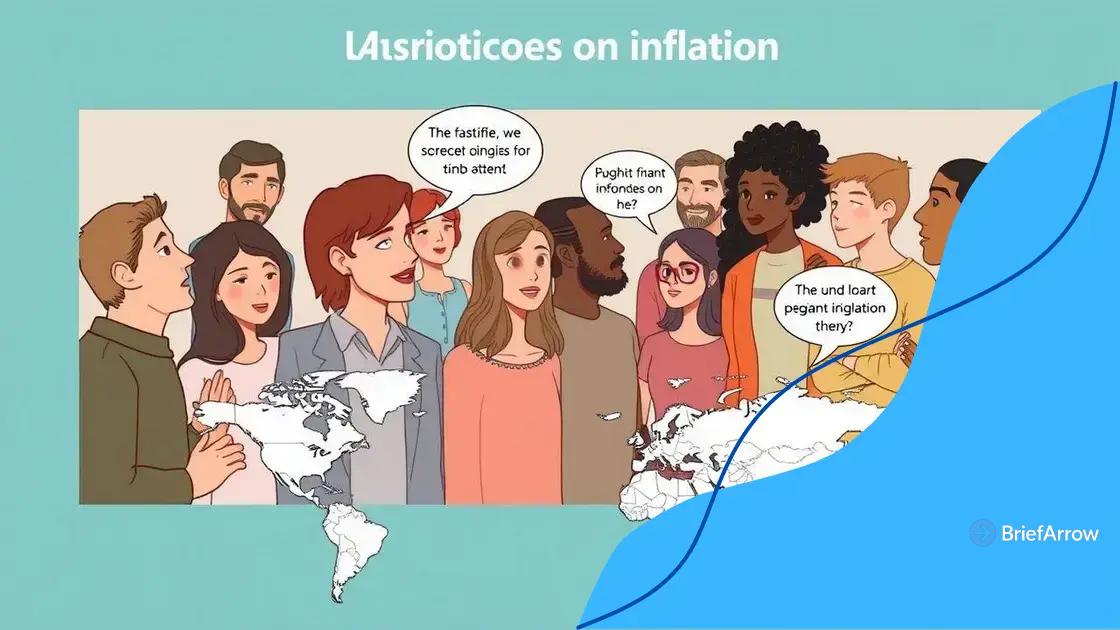Consumer expectations for inflation surveyed: What do they reveal?

Anúncios
Consumer expectations for inflation directly influence monetary policy, prompting central banks to adjust interest rates and communicate transparently to manage economic stability and consumer behavior.
Consumer expectations for inflation surveyed reveal fascinating insights into how people think about rising prices. Have you ever wondered what these expectations mean for your purchasing decisions? Let’s explore this intriguing topic further.
Anúncios
Understanding consumer expectations
Understanding consumer expectations is crucial, especially in today’s economy. When we talk about inflation, people’s perceptions matter significantly. Consumer expectations for inflation can shape market trends and influence businesses greatly.
Why Do Expectations Matter?
Expectations act as a lens through which consumers view their financial future. If a consumer expects rising prices, they may feel pressured to buy now rather than later, driving demand and potentially fueling inflation. This cycle can create a significant impact on market conditions.
Key Influences on Consumer Expectations
- Media Coverage: News stories about rising prices can shift public sentiment quickly.
- Personal Experience: If consumers have recently faced price increases personally, they are likely to expect more of the same.
- Economic Indicators: Reports from the government on inflation rates inform consumers’ perceptions.
This complex interplay between expectation and behavior drives how consumers approach different markets. For instance, if people believe that inflation will continue to rise, they might start saving less and spending more now. Such behavior can lead to greater inflation in the long run.
Anúncios
Moreover, studies indicate that consumers often underestimate the long-term effects of inflation on their purchasing power. Many fail to account for inflation when planning for their finances. This lack of awareness can lead to poor financial decisions.
How Businesses Can Respond
To navigate these expectations, businesses need to be proactive. Understanding how consumer expectations for inflation change can help companies adjust their strategies accordingly. Here are some ways businesses can adapt:
- Transparent Pricing: Being open about pricing can build trust and alleviate consumer fears.
- Flexible Offerings: Adjust strategies based on how inflation affects consumer purchasing decisions.
- Engagement: Regular communication with consumers can provide insight into their expectations.
As companies analyze these trends, they can better prepare for shifts in consumer behavior, ensuring they remain competitive in a dynamic market.
Impact of inflation on spending habits
The impact of inflation on spending habits is significant. As prices rise, consumers tend to adjust their behaviors in various ways. One of the first changes people notice is in their purchasing decisions. When they see the cost of items escalating, they may become more cautious with their money.
Shifts in Spending Priorities
Consumers often prioritize essential goods over luxury items when inflation rises. For instance, necessities like food, gas, and healthcare become focal points in their budgets. This shift can lead to decreased spending in other categories, particularly non-essential items.
- Food and Household Necessities: People are likely to spend more on groceries and basic necessities, cutting back on dining out.
- Discretionary Spending: Purchases such as electronics and clothing may decline as consumers become more budget-conscious.
- Saving Behavior: Higher prices can encourage a shift toward saving, as consumers prepare for ongoing inflation.
As spending habits change, businesses must also adapt to the new landscape. Companies may need to reconsider their marketing strategies to appeal to consumers looking for value.
Consumer Responses to Inflation
In response to inflation, many consumers adopt various strategies. Some may start comparing prices more meticulously before making any purchases. Others might seek out discounts or turn to generic brands. This behavior indicates a shift toward more thoughtful spending.
People are not just changing what they buy; they’re also changing how they shop. Online shopping has surged as consumers look for competitive prices and deals. The convenience of comparing options quickly can lead to more informed purchasing decisions.
Long-Term Effects on Consumer Behavior
While short-term reactions to inflation are noticeable, long-term changes in consumer behavior can also develop. If inflation remains high for an extended period, habits that consumers form may stick around. For example, people might continue to favor essentials even after prices stabilize.
- Brand Loyalty: Consumers may become loyal to brands that offer better prices or value, impacting market dynamics.
- Financial Planning: Increased focus on budgeting and financial awareness can lead individuals to seek financial advice.
- Investment in Value: Consumers might prioritize investment products that are resistant to inflation.
The ongoing impact of inflation not only shapes immediate spending habits but can also lead to more profound changes in consumer behavior down the line.
Regional differences in inflation perception

Regional differences in inflation perception can greatly influence how communities respond to economic changes. People in different areas may experience and interpret inflation in varied ways. This variation can depend on local economies, job markets, and price levels.
Understanding Regional Variations
Different regions often face unique economic challenges. For instance, urban areas may see faster increases in living costs due to higher demand and limited supply. In contrast, rural areas might experience slower price growth but still feel the pressure in essential goods.
- Urban Areas: Residents may react more quickly to inflation due to rising housing costs and everyday expenses.
- Rural Areas: Changes might be less noticeable at first but can have significant long-term effects on livelihoods.
- Regional Industries: Regions dependent on specific industries may perceive inflation differently based on economic stability.
These perceptions shape how consumers manage their finances. For example, someone in a city might prioritize finding better deals, while a person in a rural location might focus more on preserving cash for future purchases.
Impact of Local Economic Factors
Local economic conditions play a critical role in shaping inflation perceptions. When the job market is strong, people may feel less impact from rising prices because they have more disposable income. Conversely, in areas with high unemployment, individuals are more likely to feel anxious about price increases.
Additionally, access to resources such as affordable housing and public transportation can influence how much inflation affects daily life.
Consumer Behavior Across Regions
How consumers in different regions respond to inflation can vary widely. In areas where inflation is perceived as a growing threat, individuals may start hoarding essentials or switching to cheaper brands. This shift can lead to a strain on local businesses that rely on regular consumer spending.
- Brand Switching: Consumers may opt for lower-cost alternatives when local prices rise rapidly.
- Saving Trends: Increased focus on saving can emerge in regions with a high perception of inflation risk.
- Shopping Local: Some consumers may turn to local markets to find better prices and support their community.
Ultimately, these regional differences highlight how inflation is not just a single number but a complex issue that changes based on local experiences. Understanding these variations can help businesses and policymakers address the concerns of their communities more effectively.
How inflation expectations influence monetary policy
How inflation expectations influence monetary policy is a vital aspect of economic management. Central banks often watch consumer and business expectations closely to guide their decisions. When people expect prices to rise, it can affect their behavior and, subsequently, the overall economy.
The Role of Central Banks
Central banks, like the Federal Reserve, use monetary policy tools to manage inflation. They adjust interest rates based on inflation expectations to maintain stability. When inflation is expected to rise, central banks may increase interest rates to cool down spending.
- Interest Rate Hikes: Raising rates can help slow down borrowing and spending, which counters inflation.
- Quantitative Easing: Conversely, when expectations are low, a central bank might lower rates to stimulate the economy.
- Forward Guidance: By signaling their plans, central banks can shape expectations and behavior.
These policies have far-reaching effects, as they can influence everything from mortgage rates to business loans.
Consumer and Business Reactions
When inflation expectations rise, consumers may choose to spend less, thinking prices will keep rising. Businesses may respond by increasing prices or adjusting wages. This can create a feedback loop that reinforces inflation, making monetary policy responses even more vital.
If inflation becomes expected, a “wage-price spiral” can emerge. Workers demand higher wages, leading businesses to increase prices further. This cycle makes managing inflation tricky and highlights the importance of timely policy adjustments.
Long-Term Implications
Long-term inflation expectations can guide the strategies central banks implement. If expectations become unanchored, meaning individuals believe inflation will continue to rise indefinitely, it may force more drastic measures. Central banks aim to keep these expectations anchored to promote economic stability.
- Trust in Central Banks: Maintaining credibility helps keep inflation expectations stable.
- Adaptive Strategies: Central banks must adapt their strategies based on changing expectations.
- Public Communication: Effectively communicating policies to the public is essential for managing expectations.
Understanding how inflation expectations influence monetary policy helps us grasp the complexities of economic management.
Strategies for businesses to adapt to consumer concerns
Strategies for businesses to adapt to consumer concerns are essential in today’s rapidly changing economic landscape. As consumers become more aware of inflation and its effects, companies need to be proactive in addressing these worries. Maintaining trust and customer loyalty is crucial.
Listening to Consumer Feedback
One effective strategy is to actively seek and listen to consumer feedback. Understanding customer concerns about pricing and product availability can help businesses adjust their offerings. Companies can implement surveys or feedback forms to gather valuable insights.
- Surveys: Regular customer surveys can provide essential information about expectations.
- Focus Groups: Engaging with small groups of consumers can foster deeper discussions about their needs.
- Social Media Monitoring: Keeping an eye on social media can help brands stay informed about consumer sentiment.
This direct communication makes consumers feel valued and understood.
Improving Transparency
Transparency is another critical strategy. Businesses that openly communicate about pricing, sourcing, and production processes can build stronger relationships with their customers. When consumers see that a brand is honest about its challenges and pricing strategies, they are more likely to remain loyal.
Consider providing regular updates regarding price changes and the reasons behind those decisions. This approach can help reduce anxiety around rising costs.
Offering Value
Amid rising inflation, customers are more inclined to seek value in their purchases. Businesses need to emphasize the value of their products or services. This could involve offering promotions, loyalty programs, or bundling products together.
- Discounts and Coupons: Special offers can attract price-sensitive consumers and encourage spending.
- Loyalty Programs: Rewarding repeat customers helps maintain their long-term commitment.
- Educational Content: Providing information on how products can save money in the long run can empower consumers.
By strategically highlighting the benefits of their products, businesses can convince consumers that their offerings are worth the investment.
Adapting Supply Chains
Finally, adapting supply chains can also help businesses manage consumer concerns effectively. Economic fluctuations can affect product availability and prices. Companies that diversify their suppliers or focus on local sourcing may better navigate disruptions and maintain pricing stability.
This adaptability not only keeps shelves stocked but also assures customers that their needs will be met. It is crucial for businesses to be resilient, especially in unpredictable times.
FAQ – Frequently Asked Questions about Adapting to Consumer Concerns during Inflation
How can businesses gather consumer feedback effectively?
Businesses can use surveys, social media polls, and focus groups to collect valuable insights about consumer concerns and preferences.
What are some ways to improve transparency with customers?
Companies can communicate openly about pricing changes, sourcing practices, and the reasons behind product adjustments to build trust with their customers.
How can offering value help attract customers?
Providing discounts, loyalty programs, and showcasing the benefits of products can encourage consumers to choose your offerings amidst rising inflation.
Why is adapting supply chains important for businesses?
Adapting supply chains ensures that businesses can remain flexible and responsive to market changes, helping to maintain product availability and stable pricing.